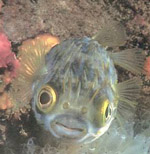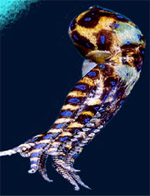 |
 |
 |
 |
 |
 |
 |
 |
 |
| |
| Any
suggestions or comments, please contact me at |
| shuyi.quek@ic.ac.uk |
| |
| |
| |
| |
| |
|
- Introduction -
 Tetrodotoxin
(TTX) is a potent neurotoxin commonly
found in puffer fish. Tetrodotoxin
(TTX) is a potent neurotoxin commonly
found in puffer fish.
It was named by Toshizumi Tahara
in the late 1880s after the order of Tetraodontiformes
(puffer fish), where it was first observed. Besides the
puffer fish, TTX has also been found in a wide range of marine species
such as, the blue ringed octopus, California Newt, Ocean sunfish,
porcupine
fish and the Costa Rican frogs amongst others.

Through the study of cultured puffer fish,
it was discovered that TTX was not
metabolically produced within
the fish. Instead, it is synthesized by several bacterial species,
including strains of the family Vibrionaceae
and Pseudomonas sp.
TTX acts on
the central and peripheral
nervous system by blocking the Sodium ion channels vital for cellular
signaling pathways (e.g. transmission of impulses and maintenance of
cell functions),
eventually leading to paralysis and even death.

The
comparative toxicity was summarized by William H. Light
who
said, ¡§[W]eight for weight, Tetrodotoxin is ten times as deadly as the
venom of many-banded krait of Southeast Asia. It is 10 to 100 times
as lethal as black widow spider venom (depending upon the species)
and more than 10,000 times deadlier than cyanide.¡¨ A small dose of
1-2mg of purified TTX is lethal.
Back
to Top
|